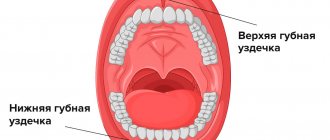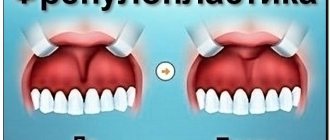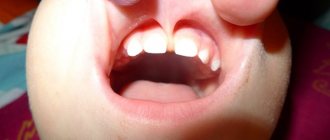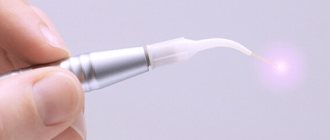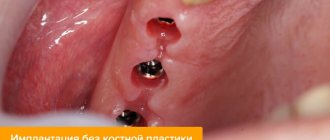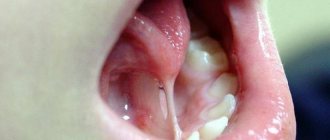May 31, 2020
Under the upper lip, right in the center of each person, there is a ligament that connects the lip to the alveolar part of the jaw and is called the frenulum. For some, this ligament is short and attached too low, which creates certain difficulties and health problems, which we will definitely talk about below. In this regard, doctors suggest that such patients undergo plastic surgery of the upper frenulum. And UltraSmile.ru journalists will tell you about the operation and its indications in detail.
There are many indications for frenuloplasty
Few people know that the upper frenulum is very important for the correct and full functionality of the dental system. Thanks also to her, we can move our lips, pronounce different sounds, and open our mouths. It also plays an important role in the formation of a beautiful smile aesthetics. If it is shortened or positioned incorrectly, then in some cases this creates conditions for the development of various anomalies and leads to serious problems and consequences, which, in fact, are indications for trimming the frenulum of the upper lip in adults and children.
At what age is it best to have surgery?
Trimming the frenulum of the upper lip is a relatively easy operation, but the optimal age for it, according to most doctors, is 5–7 years, when the permanent incisors begin to emerge. If you carry out the procedure during this period, you can avoid the formation of a diastema and further manipulations to correct the bite by the orthodontist. But according to indications, it is not too late to perform plastic surgery in adolescence, and even in adults.
“I took my child to this operation. My son was 8 years old at the time. He already understood everything that was said to him, and at the same time he was very afraid. Before the operation, we sat and calmed down in the doctor’s office for about 15 minutes. I want to say that the child’s psychological attitude is very important here. About the operation itself: it didn’t hurt, my son didn’t cry. But after the anesthesia began to wear off, he complained that his gums hurt, but this problem was solved with Nurofen syrup. Already on days 4–5, the trace of the wound was almost invisible, although it was done with a scalpel. But in children everything heals quickly.”
Lada, review from the dental portal gidpozubam.ru
The operation is best performed at the age of 5-7 years
What are the differences between upper and lower lip frenuloplasty?
Although the operations themselves to correct pathology on the upper and lower lips are similar, they require a different approach to rehabilitation. After plastic surgery of the lower lip frenulum, the wound takes longer to heal, about two weeks, while plastic surgery of the upper lip frenulum requires only a few days to recover. In the first case, anti-inflammatory therapy is often prescribed to prevent complications.
Types and technologies of upper frenuloplasty
Before the procedure, it is important to carry out a complete sanitation of the oral cavity, treat diseased teeth and stop acute inflammatory processes, remove bacterial plaque - all these are sources of infection, which can subsequently provoke postoperative complications. You should also eat before surgery, as hunger can impair blood clotting.
There are several techniques for performing the procedure. The doctor decides which one to use depending on the patient’s age, the location and attachment of the frenulum. Let's list all the technologies that exist today:
- frenotomy, or frenulotomy: involves transverse dissection of the frenulum if it is very narrow and thin. This is the so-called minor operation, which is considered the least traumatic. The purpose of the manipulation is to relieve the tension of the ligament. The procedure can be performed on newborns, as well as older children,
- frenectotomy: this is a more complex operation, during which the frenulum of the upper lip is trimmed and part of the tissue located in the space between the central incisors is removed. The procedure is performed if the frenulum is thick, as is often the case in adolescent and adult patients,
- frenuloplasty: the doctor releases the ligament and moves it to the area where it should be.
The operation is performed under local anesthesia.
Each of the listed operations is performed on an outpatient basis, under local anesthesia. Traditionally - using a scalpel. Afterwards, the doctor applies self-absorbing sutures and sends the patient home. Everything lasts about 10–15 minutes. Next, the patient receives clear recommendations on how to behave during the rehabilitation period. 1 and 3 days after the operation, you need to visit the doctor again for follow-up examinations.
Today, plastic surgery of the upper frenulum can be performed using a laser, which allows the procedure to be carried out quickly, without pain and blood, and to disinfect the operated tissues. This also reduces the likelihood of developing postoperative complications (swelling, pain, inflammation, scars). A big advantage is that when using laser equipment there is no need to apply stitches.
Laser frenulum trimming is the least traumatic
The rehabilitation period takes about 10–14 days. During this time, the patient is not recommended to eat food that can irritate the operated tissues (cold, spicy, hot, hard). It is also necessary to rinse your mouth with an antiseptic and apply wound-healing ointments (for example, Solcoseryl).
Notice
: Undefined variable: post_id in
/home/c/ch75405/public_html/wp-content/themes/UltraSmile/single-item.php
on line
45 Notice
: Undefined variable: full in
/home/c/ch75405/public_html/wp-content /themes/UltraSmile/single-item.php
on line
46
Rate this article:
( 3 ratings, average: 5.00 out of 5)
prevention
- Alimirzoev F.A. Dental anomalies in childhood and their diagnosis // Achievements of university science. – 2014.
What is labial frenuloplasty?
The labial frenulum is a fold of mucous membrane that connects the lip and gum. Plastic surgery of the frenulum of the upper and lower lips is done to eliminate pathologies that can have unpleasant consequences in the form of impaired diction and the formation of malocclusion. This operation itself is very simple and has minimal contraindications. It is done if the frenulum is too short or too wide, which affects the position of the teeth and the condition of the gums. For example, due to a wide frenulum, a diastema may appear - a gap between the central incisors. In this case, either surgery using the classical method or laser plastic surgery of the upper lip frenulum will help.
Sometimes plastic surgery is performed on the frenulum of the tongue - the membrane connecting the lower part of the tongue and the mucous membrane of the lower jaw. In children, surgery promotes the correct formation of the bite and prevents speech defects; in adults, it is a necessary measure for effective prosthetics with a removable structure or implantation. Read more about tongue frenuloplasty here.
Comments
Which doctor can give a referral for this operation?
Marina (06/14/2020 at 07:28 pm) Reply to comment
- You can get a referral after an examination by a dentist or periodontist, orthodontist, speech therapist, or neonatologist (for newborns). The operation itself is performed by a dental surgeon.
Editorial staff of the portal UltraSmile.ru (06/17/2020 at 09:07) Reply to comment
Write your comment Cancel reply
When is lip frenuloplasty required?
The pathology of the labial frenulum does not always indicate that the patient requires surgery. Sometimes it is minor and does not cause any particular inconvenience. As a rule, surgery is necessary in the following cases.
- Diastema.
The excess gap between the central incisors tends to widen, causing the teeth to move forward and move apart in different directions. Also, constant stress on the gums leads to periodontitis. - Orthodontic treatment.
Correcting the bite with braces requires that the frenulum be of the correct shape and have an anatomical location. Therefore, before starting treatment, the orthodontist often sends the patient for plastic surgery. - Periodontal diseases.
A short frenulum can expose the roots of the teeth. - Complete prosthetics.
A short frenulum does not allow a removable denture to be firmly and securely fastened. This is one of the most common cases when plastic surgery of the lower lip frenulum is performed in adults.
Photo of a short frenulum of the upper lip in a child.
Short frenulum of the upper lip in a newborn: etiology and pathogenesis
The reason for the appearance of this feature in a newborn is a violation of the formation of the mucous membranes of the mouth and congenital anatomical anomalies of the oral cavity. The etiology of this defect is determined by various hereditary and external risk factors during the first trimester of pregnancy, when the embryo develops the facial skeleton and oral cavity.
Lip frenulums are thin triangular mucous bridges located vertically between the middle of the lip and the middle of the gum (alveolar process of the jaw). These movable thin bridges serve as limiters for lip mobility.
Most often, the pathogenesis of the defect is caused by the fact that the connection of the frenulum with the gum occurs below the base of the gingival papilla, that is, too close to the teeth. There are also various types of defects in the shape of the bridle itself - compaction, thickening, curvature of the shape, shortening of the free side. These defects lead to the fact that the upper lip becomes inactive, does not completely cover the upper row of teeth, and the patient experiences difficulty closing the lips.
Frenules in the oral cavity
These small mucous strands can affect the clarity of speech, the aesthetics of a smile; in infants, the frenulum of the oral cavity can affect the quality of attachment to the breast, or the ability to suck a bottle. It is for this reason that parents should pay attention to these anatomical formations. If the frenulum(s) of the oral cavity are short, the baby will not be able to eat properly, attach to the breast, and therefore will get tired faster, remaining hungry. There can be no talk of any increase in the child’s weight or height. Parents should remember and be aware of this problem and be able to notice alarming symptoms. According to statistics, a large percentage of short frenulums are registered in children, on average every 14 children. If the problem is diagnosed in time, it is possible to avoid those complications that can cause short frenulum. Anatomy of the oral cavity There are three frenulums in the child’s oral cavity , and not one, as many parents believe. After all, the more “ famous ” is the frenulum of the tongue, which is attached to the underside of the tongue and sublingual space. The frenulum of the tongue is rightfully considered the most insidious, but at the same time practically the most important. In addition to the frenulum of the tongue, in the baby’s mouth there are also frenulums of the upper and lower lips, which are also assigned certain functions. The frenulum on the upper lip should be woven into the upper lip and into the mucous membrane of the gums, just above the level of the front incisors. The frenulum on the lower lip is woven in the same way as the upper lip. As a rule, a short frenulum in the mouth can be diagnosed in the parent department; this is more true for a short frenulum of the tongue. As for the rest of the frenulum of the oral cavity, diagnosis mainly occurs in the dentist's chair at a random appointment. There are cases when a tongue frenulum is not immediately diagnosed, and the frenulum in no way interferes with the feeding of the baby. But subsequently, the child may pronounce incorrectly defined sounds, and then the question of a short frenulum of the tongue comes up again, which, as a rule, is diagnosed at an appointment with a speech therapist. Upper lip frenulum When diagnosing a short frenulum, there are usually no difficulties, even for parents. To do this, you just need to carefully pull back the upper lip at rest and see at what level the mucous cord is attached. Normally, attachment should occur 5–8 mm from the neck of the child’s incisors. If the frenulum is attached lower or its attachment is not visible at all, then we can talk about a short frenulum. What are the dangers of having a short frenulum? In a newborn baby, a short frenulum on the upper lip can affect breastfeeding; the baby simply cannot position the upper lip correctly and correctly grasp the mother's breast. Only in this case can the frenulum of the upper lip be corrected in the maternity hospital. Fortunately, this happens quite rarely. At an older age, a short frenulum in the oral cavity can affect the aesthetics of a smile, since a gap is formed between the child’s front teeth - a diastema (trema). Typically, children are embarrassed by such diastemas, especially teenagers, and try to smile or talk less. Such gaps between teeth are considered dental defects that require orthodontic treatment, sometimes in combination with surgery. But it is worth remembering that an aesthetic defect is not the only problem that can be caused by a short frenulum of the upper lip; the most serious complication is problems with bite, namely the protrusion of the front incisors forward. The protrusion of the front incisors occurs as a result of pressure. The fact is that when talking or eating, the lips are involved, and the frenulum connects the lip and the alveolar process and pulls it along with it, while mechanically acting on the jaw in the area of the incisors, promoting their advancement forward. The solution to this problem is orthodontic, and requires a fairly large investment of time and money. In fairness, it is worth noting that such a scenario can only develop in children with permanent incisors; if the baby still has a milk bite, then there is no need to worry. Excessive tension of the gum mucosa can provoke inflammatory diseases in the area of the front incisors - gingivitis, periodontitis. As a result, the child may develop increased tooth sensitivity. Speech defects may also be characteristic of a short frenulum; the toddler cannot correctly pronounce some sounds that the baby uses his lips to pronounce, such as “o”, “u”, etc. In addition, inflammatory diseases in the gum area can cause caries in the area of the necks of the teeth. Due to the low attachment of the frenulum, a large amount of plaque accumulates in the incisor area, and it is quite difficult to remove. How does the correction happen? Correction can be done exclusively surgically, but it is worth remembering some features. Correction of the frenulum on the upper lip is indicated only after or during the eruption of the permanent incisors! Usually this is 6 - 8 years old; until this age, parents should not worry. It is not recommended to perform the operation before this period, with the only exception in the maternity hospital. Otherwise, such actions may result in bite pathology. A shortened and thick frenulum of the upper lip in a primary occlusion is not a pathology, but a variant of the norm; as the jaws grow, the frenulum can self-correct, i.e. stretch out and change its place of attachment. It is for these reasons that the most optimal time for correction is the time when all the permanent incisors on the upper jaw have erupted, and active eruption of the canines begins, or when the anterior permanent incisors are erupting, and when the lateral incisors are actively erupting. The fact is that when the frenulum is corrected at this time, the erupting teeth will move the teeth towards each other and the gap between the teeth will close on their own, and there will be no need for orthodontic treatment. If it was not possible to correct the frenulum in time, it is necessary to use orthodontic treatment, when the doctor places a “brace” on the front teeth, which will bring the incisors together. Surgical treatment Dentists can use 3 types of surgical treatment : Frenotomy - dissection; Frenectomy - excision; Frenuloplasty – relocation of the frenulum attachment site. Children can cut the frenulum on their own, and cases of such injuries are quite common. For example, if you fall or chew toys too hard, the frenulum may rupture, which is accompanied by bleeding and hematoma. In case of injury, you must immediately consult a dentist to decide the future fate of the injured frenulum. Frenectomy allows you to solve this problem, and even with trauma to the oral cavity, ruptures of the frenulum, as a rule, do not occur. The operations themselves are performed in a surgical clinic, using local anesthesia, and the procedure usually does not take more than 30 minutes. After cutting the frenulum, the doctor places sutures made of a special biomaterial that dissolves on its own, which avoids the unpleasant procedure of removing them. The recovery period after the procedure is not long and takes from several hours to several days. And as soon as the swelling subsides after the operation, parents note that the child begins to pronounce sounds more clearly, or grasps the mother’s breast more freely. The operation can be performed using various instruments - surgical scissors or a scalpel, or using a laser. Using the latter technique is the most acceptable, as it avoids stitches and significantly reduces the baby’s recovery time. Most often, the frenulum is corrected in young children using a scalpel, the amount of time spent is reduced, and immediate attachment to the chest is a prerequisite. Frenulum on the lower lip The frenulum of the lower lip may not be present or it may be forked. In order to diagnose a frenulum on the lower lip, it is necessary to retract the lower lip. At the same time, the frenulum itself becomes noticeable, which runs from the middle of the alveolar process of the lower jaw, intertwining below the area of the lower incisors, and attaching to the lower lip. Under normal conditions, the frenulum should be thin and almost invisible, in addition, it should be flush with the center line. If the baby's frenulum is thick, short and attached at the base of the lower incisors, the frenulum is short. Why is a short frenulum of the lower lip dangerous? By analogy with the frenulum on the upper jaw, the sucking function of a toddler may suffer. When sucking, the short frenulum pulls the lower lip along with it, thereby breaking the vacuum that is formed during sucking. The baby needs more effort, the baby quickly gets tired, remaining hungry and abandoning the breast. In this case, frenuloplasty can be performed in the maternity ward. A short frenulum can also cause malocclusion, inflammatory and carious diseases in the area of the lower front incisors. The formation of spaces between the lower anterior incisors is a rather rare phenomenon, but can still be diagnosed if the frenulum is woven into the area of the gingival papilla between the anterior incisors of the lower jaw. Treatment The operation can be performed on children of different ages, but most often these are children with fully erupted permanent incisors. No less often, the frenulum can be cut already in adulthood, when it comes to prosthetics of the lower jaw. The operation itself is carried out in a clinic, using local anesthesia, and 2 operations can be used to correct the frenulum - frenotomy, frenectomy. Tongue frenulum It is this frenulum that can influence the movement of the tongue; most often it limits this movement. The tongue is the most important organ in the oral cavity, which is involved in many functions - speech formation, nutrition, breastfeeding and much more. Normally, the mucous cord is woven from the inside of the tongue approximately in the middle, and connects to the sublingual space. The normal length of the frenulum is about 8 mm. If a toddler’s frenulum is attached almost to the tip of the tongue, then this is a clear indication for correction. This classic sign of a short frenulum of the tongue is not always found; there are other symptoms that can be used to diagnose its shortening. Doctors usually use a simple test that parents can use too. When the baby’s mouth is open, you need to ask her to touch the very roof of her mouth, and if the baby reaches without difficulty, everything is normal. But if a child experiences a painful reaction, or the child simply cannot perform this operation, this is a reason to contact a doctor. The only drawback of this test is the age restrictions for children; such a test can only be performed on children over 3 years old. If the baby is younger, then he can simply refuse to carry out such manipulation. There is also a set of tests for younger children; doctors usually ask or provoke the child to show his tongue. And at the same time, the doctor evaluates how much the baby’s tongue can come out of the mouth. Why is a short oral frenulum dangerous? Every mother should pay attention to feeding the baby, monitor his reaction, pay attention to the sounds the baby makes, and weight gain. With a short frenulum of the tongue, the baby simply cannot properly place his tongue under the mother’s nipple, it turns out that the baby cannot grasp the breast correctly, and “clicking” sounds may occur during feeding. In addition to inadequate breastfeeding and problems for the mother, the baby spends more effort to get enough, the baby's sucking activity gradually decreases, and the feeding time itself increases, during which the baby takes a short break. The baby tries to compensate for the greater amount of effort by clenching his jaws, and often when feeding, babies bite their mother's breast. Often such children set their own feeding schedule, since full saturation occurs over a longer period of time; usually babies eat approximately every two hours. Weight gain is at the lower limit of normal, or even lags behind. The frenulum may not be diagnosed in infancy, and can be detected during the period when the baby begins to actively talk. Babies with a short frenulum of the tongue cannot correctly pronounce quite a lot of sounds, namely those sounds in which the tongue should touch the palate or upper incisors - “r”, “sh”, “sch”, “ch”, “ry”, etc. Diagnosis of the frenulum often occurs at an appointment with a speech therapist, from where parents receive a referral to a dentist. Treatment Treatment can take place in two ways - surgical or speech therapy; often a combination of these two methods occurs. Parents should remember that the choice of treatment method lies entirely on the shoulders of the dentist, and not the speech therapist. Surgical correction of the frenulum The frenulum can be corrected in the maternity hospital, the operation is carried out in the obligatory presence of the mother, and after the operation the baby must be immediately applied to the breast. There are no nerve endings in the frenulum itself, but there are blood vessels; there are none in the place where the dissection occurs, therefore, there is no pain or bleeding. Babies can simply get scared, and applying to the breast is more of a calming maneuver. In young children, correction is most often carried out using a laser, which eliminates the need for stitches and reduces recovery time. In older children, namely school children, it is performed under local anesthesia. In this case, the doctor cuts the frenulum and applies sutures using a classic set of instruments. It is more advisable to use a laser scalpel. When using it, the time of the operation itself is reduced, and there is no need for sutures. After rehabilitation, the baby must follow a special gentle diet and perform the exercises recommended by the dentist or speech therapist. These exercises are aimed at training the frenulum. If the frenulum is not very shortened, then it is possible to solve the problem without surgery, but only if the child is less than 5 years old. Speech therapy exercises Exercises can be different, and the choice will depend on the age of the child. For the little ones, you can offer play exercises where the baby’s tongue will be used, for example, the “kitten” exercise - the baby is asked to lick a saucer like a kitten. You can use the “ horse ” exercise, ask the baby to click like a horse, while the tongue rises to the palate, tension and stretching of the frenulum occurs, which trains it. At the appointment, the speech therapist can massage the frenulum using special tools or with the help of hands. It is worth remembering that the child gets tired quite quickly, and unpleasant sensations, even pain, may occur. That is why the load must be increased gradually, and it is precisely this fact that is associated with the fact that speech therapy treatment does not give quick results, and in most cases it is impossible to do without surgical intervention. And when diagnosing a short frenulum, it is necessary to consult a speech therapist and a dentist, but the final word remains exclusively with the dentist.
